
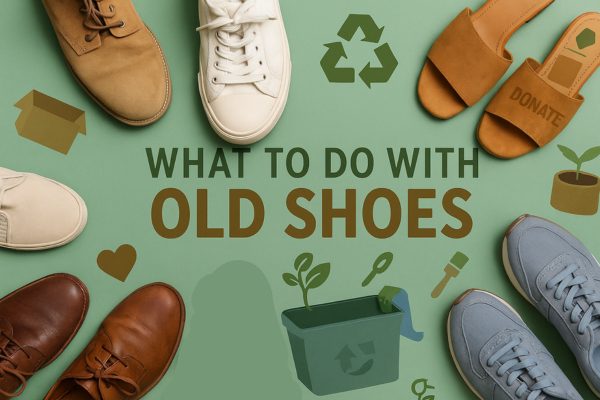
Every year, Americans toss 300 million pairs of shoes into the trash, creating mountains of waste that take 30-40 years to decompose. But what if those worn-out sneakers gathering dust in your closet could help someone in need or become playground equipment instead?
The good news is you have three main options for getting rid of old shoes sustainably: donate them if they’re still wearable, recycle them through specialized programs, or repurpose them into creative household items. Each method keeps shoes out of landfills while benefiting either people or the planet.
This comprehensive guide covers everything from assessing whether your shoes are donation-worthy to finding local recycling centers and transforming old footwear into garden planters. You’ll discover specific programs for every shoe type, learn preparation techniques, and even find ways to earn money from your old kicks.
When faced with a pile of old footwear, you have three sustainable paths: donate shoes in good condition to charities like Soles4Souls, recycle worn-out pairs through programs like Nike Grind, or repurpose them into creative DIY projects. The best choice depends on your shoes’ condition and your local recycling options.
Here’s a simple decision framework to guide you:
| Shoe Condition | Best Option | Example Programs |
|---|---|---|
| Like new, minimal wear | Donate | Goodwill, Dress for Success |
| Worn but wearable | Donate or Sell | GotSneakers, Salvation Army |
| Damaged or worn out | Recycle | TerraCycle, Nike Reuse-A-Shoe |
| Beyond repair | Repurpose or Recycle | DIY projects, local e-waste centers |
For immediate action, check if your shoes pass the “donation test” – would you feel comfortable giving them to a friend? If yes, donate. If not, explore recycling or creative reuse options detailed in the sections below.
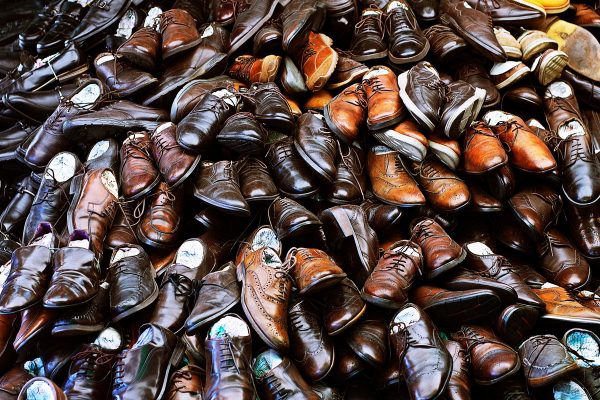
The environmental consequences of improper shoe disposal extend far beyond cluttered landfills. When you throw shoes away in regular trash, they release toxic chemicals including lead, mercury, and brominated flame retardants that contaminate soil and groundwater for decades.
Modern athletic shoes contain EVA foam, synthetic rubbers, and plastics that never fully biodegrade. These materials break down into microplastics that infiltrate food chains and water systems, affecting wildlife and human health alike.
The sheer volume compounds the problem – with 22 billion shoes produced globally each year, improper disposal creates massive environmental burdens. Each pair takes up valuable landfill space while leaching harmful substances that could have been safely managed through proper recycling shoes programs.
Your worn-out sneakers contain surprising amounts of valuable materials waiting for recovery. The average shoe harbors 0.034 grams of gold, 0.34 grams of silver, and 25 grams of aluminum, materials that maintain their properties through infinite recycling cycles.
Beyond precious metals, shoes contain high-quality rubber suitable for playground surfaces, foam perfect for carpet padding, and textiles that become insulation materials. The metal recycling industry particularly values shoe components like eyelets, shanks, and buckles.
This material recovery creates significant economic value – the shoe recycling sector employs thousands while providing cost-effective raw materials for manufacturers. Recycling these materials uses 74% less energy than producing new ones, translating to both environmental and economic benefits.
Before deciding what to do with old worn out shoes, consider whether simple repairs could extend their life. Many footwear issues that seem terminal actually have straightforward fixes that cost far less than replacement.
Common repairable problems include:
Professional cobblers can work miracles on quality footwear, especially leather shoes and boots. The investment often pays off – resoling extends shoe life by years while maintaining the comfort of already broken-in footwear.
Determining whether shoes qualify for donation requires honest assessment. Ask yourself: would I feel comfortable giving these to a friend or family member? This simple question cuts through uncertainty about donation standards.
Shoes suitable for donation should have:
Even shoes with minor cosmetic flaws often find grateful recipients through donation programs. What matters most is that they provide safe, comfortable wear for someone who needs them.
Use this detailed assessment guide to determine the best disposal method for your footwear:
| Assessment Category | Repair | Donate | Recycle | Trash |
|---|---|---|---|---|
| Sole Condition | Worn but attached | Good tread remaining | Holes or detached | Completely destroyed |
| Upper Material | Repairable damage | Minor wear/scuffs | Major tears | Biohazard contamination |
| Odor Level | Treatable | None to mild | Strong but cleanable | Permanent/mold |
| Overall Structure | Sound construction | Maintains shape | Broken but material good | Falling apart |
| Estimated Cost | Under $80 to fix | Free disposal | May earn money | Last resort only |
Several nationwide organizations make donating used shoes simple and impactful. These programs ensure your footwear reaches people who genuinely need them while keeping wearable shoes out of landfills.
Soles4Souls leads global shoe distribution, having delivered over 83 million pairs across 127 countries. They accept all types of gently worn footwear through drop-off locations at DSW, Zappos, and partner retailers nationwide.
Goodwill operates donation centers in nearly every US community, accepting clean shoes alongside other clothing. Your donated footwear funds job training programs while providing affordable options for budget-conscious shoppers.
GotSneakers offers a unique model – they pay you for wearable sneakers while recycling those too worn for reuse. Request a free collection kit online, fill it with sneakers, and receive payment based on shoe condition.
Targeted donation programs match specific shoe types with communities that need them most. These organizations understand that different situations require different footwear solutions.
Dress for Success specifically seeks women’s professional shoes suitable for job interviews and workplace settings. They accept pumps, flats, and conservative dress shoes that help women enter or re-enter the workforce with confidence.
One World Running collects athletic shoes for aspiring runners in developing nations who lack access to proper footwear. Since 1986, they’ve distributed thousands of pairs to athletes training on rough terrain without adequate gear.
Share Your Soles (Chicago area) focuses on dignity through direct distribution. They ensure donated shoes reach recipients in respectful ways that preserve self-worth while meeting practical needs.
Proper preparation ensures your donated shoes provide maximum benefit to recipients. Start by thoroughly cleaning each pair – remove dirt, debris, and any removable insoles that need washing.
Steps for donation preparation:
For tax purposes, photograph your donations and keep receipts from drop-off locations. The IRS allows deductions of $3-9 per pair depending on condition, which adds up for larger donations.
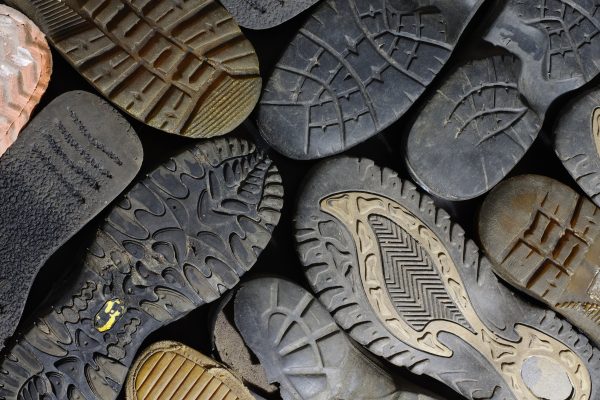
The journey of recycled shoes into new products involves sophisticated separation technology that maximizes material recovery. Modern facilities use advanced systems to transform what to do with old shoes that need to be recycled into valuable raw materials.
First, shoes undergo manual sorting by type and material composition. Workers remove non-recyclable components like metal eyelets (sent to specialized metal recycling streams) before the main processing begins.
Next, industrial shredders break shoes into small pieces, followed by separation equipment that sorts materials by density. Cyclonic separators pull out foam, vibrating tables separate rubber, and magnetic systems extract remaining metals. The ECOFLAKE system achieves over 90% purity in material separation.
Finally, sorted materials enter specific recycling streams – rubber becomes playground surfaces, foam transforms into carpet padding, textiles become insulation, and leather finds new life in composite materials.
Multiple options exist for recycling scraps of rubber soles and other shoe materials, from convenient retail drop-offs to comprehensive mail-in programs.
Nike Reuse-A-Shoe accepts any brand of athletic shoes at participating Nike stores across the US and Europe. Since 1992, Nike Grind has recycled 130 million pounds of footwear into sports surfaces and new products.
TerraCycle Zero Waste Box provides a mail-in solution for all shoe types. While boxes start at $129, they’re ideal for community collections or offices wanting to recycle shoes collectively. TerraCycle handles even difficult materials like leather and mixed composites.
Local recycling centers increasingly accept footwear, especially those with textile recycling programs. The Green Directory helps locate nearby facilities that process shoes along with other materials.
Proper preparation significantly improves recycling efficiency and material recovery rates. Unlike donation prep, recycling focuses on material cleanliness rather than appearance.
Essential recycling preparation:
Some programs prefer shoes tied together to prevent separation during processing, while others want them loose for easier sorting. Check specific requirements for your chosen recycling method.
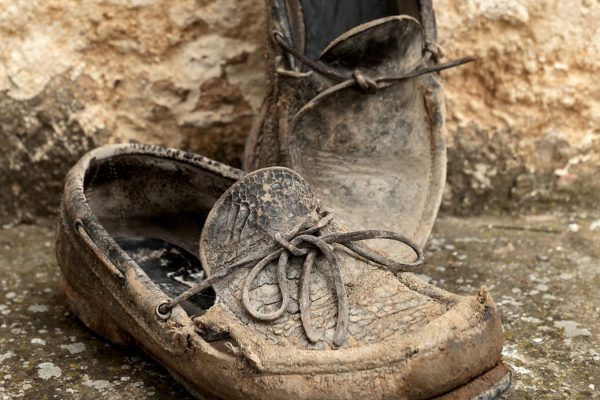
Transform worn footwear into functional garden accessories that add character while serving practical purposes. Old shoes make excellent planters for small herbs, succulents, or trailing flowers.
Shoe Planter Instructions:
Rubber boots work particularly well as hanging planters, while canvas sneakers create whimsical displays for patios. Weather-resistant shoes last longer outdoors, though any footwear works for covered areas.
Bird feeders represent another creative option – simply nail an old shoe to a tree or post, fill the toe area with seed, and watch feathered friends enjoy your upcycled creation.
Indoor repurposing projects turn old footwear into conversation pieces that solve storage challenges. High heels mounted on boards become unique coat hooks, while boots serve as umbrella stands.
Baby shoes transform into adorable pincushions for crafters – stuff firmly with sawdust or crushed walnut shells, cover the opening with fabric, and display in your sewing area. These sentimental keepsakes preserve memories while serving practical purposes.
Sneakers mounted on garage walls create tool storage for lightweight items like gloves, twine, or seed packets. The shoe compartments naturally organize small items while adding visual interest to utilitarian spaces.
Children love transforming old shoes into creative projects that encourage imagination while teaching sustainability. These activities work well for rainy days, scout troops, or classroom projects.
Popular kids’ shoe crafts include:
Adult supervision ensures safety when using tools or adhesives. These projects teach children that what can I do with old shoes extends beyond disposal into creative reuse.
Athletic cleats require special consideration due to their specialized construction and materials. The combination of metal or plastic spikes with synthetic uppers creates unique recycling challenges.
Many youth sports leagues organize cleat drives, collecting outgrown pairs for redistribution to underfunded programs. These initiatives ensure expensive specialty footwear reaches young athletes who need it most.
For worn-out cleats, remove metal spikes before recycling – these go to metal recycling streams separately. Plastic-spiked cleats can stay intact for shoe recycling programs that accept mixed materials.
Shoes containing batteries or LED lights require hazardous waste disposal due to mercury and other toxic components. Never place these in regular trash or standard shoe recycling bins.
Electronic shoe disposal steps:
Some retailers like Best Buy accept small electronics including light-up shoes during special collection events. These ensure safe handling of mercury-containing components.
Quality leather footwear often outlasts synthetic alternatives, making repair particularly worthwhile. When leather shoes finally reach end-of-life, they require different recycling approaches than synthetic materials.
Leather recycling faces challenges due to tanning chemicals, but specialized facilities process leather into composite materials for automotive and furniture industries. Clean, chemical-free leather pieces work well for craft projects.
Consider these leather-specific options:
Digital tools simplify locating appropriate disposal options for any shoe type or condition. These resources connect you with nearby facilities while providing specific acceptance criteria.
The Green Directory serves as a comprehensive database – simply enter “shoes” and your ZIP code to find local recycling and donation options. Results include hours, accepted materials, and preparation requirements.
Earth911’s recycling search offers another excellent resource, with detailed filters for shoe materials and conditions. Their database covers over 350 materials across 100,000+ locations nationwide.
Brand-specific store locators help find retailer take-back programs. Nike, Adidas, and other major brands increasingly offer in-store recycling, though availability varies by location.
Choosing between mail-in and local drop-off depends on convenience, cost, and environmental considerations. Each method offers distinct advantages for different situations.
Drop-off benefits:
Mail-in advantages:
Consider carbon footprint when choosing – local drop-off typically generates fewer emissions unless combining mail-in with other errands. For rural areas lacking nearby facilities, mail-in provides the only viable recycling option.
The most damaging mistake is simply tossing shoes in regular trash without considering alternatives. This seemingly convenient choice contributes to the 300 million pairs annually clogging landfills unnecessarily.
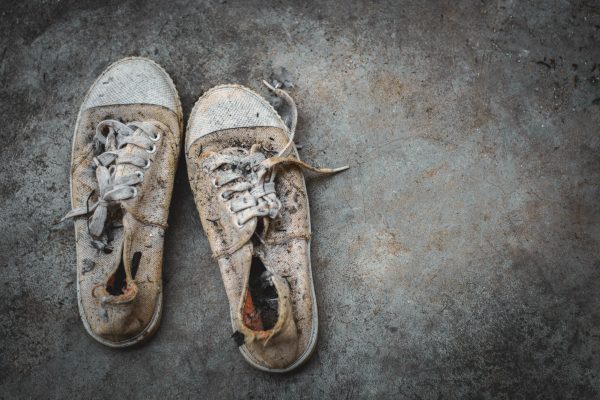
Donating contaminated footwear ranks second in disposal errors. Moldy, excessively dirty, or odorous shoes contaminate entire donation batches, forcing charities to pay for disposal. When wondering how to dispose of old shoes properly, remember that donation programs need saleable items.
Missing valuable recycling programs costs both environmentally and financially. Many people remain unaware that programs like GotSneakers pay for certain shoes or that retailer programs offer store credit for trade-ins.
Overlooking tax deductions for donated shoes leaves money on the table. Proper documentation of charitable donations can yield significant tax benefits, especially for higher-value footwear in good condition.
Smart shoe purchasing and care dramatically reduces disposal frequency while saving money long-term. Invest in quality, repairable footwear rather than disposable fast fashion that quickly becomes waste.
Rotation strategies extend shoe life significantly – alternating between multiple pairs allows materials to fully dry between wears, preventing breakdown from moisture accumulation. This simple practice can double footwear lifespan.
Seasonal storage protects off-season shoes from damage. Clean thoroughly, stuff with paper to maintain shape, and store in breathable containers away from extreme temperatures. Proper storage prevents deterioration during months of non-use.
Support circular economy brands designing shoes for end-of-life recycling. Companies like Adidas (Futurecraft.Loop) and Reebok (Cotton + Corn) create footwear specifically engineered for complete recyclability, simplifying future disposal.
No, standard curbside recycling programs cannot process shoes due to their complex material composition. Shoes require specialized recycling facilities equipped to separate rubber, foam, leather, and textiles – capabilities that municipal recycling centers lack.
Placing shoes in regular recycling bins contaminates other recyclables and may result in entire loads going to landfills. Instead, use dedicated shoe recycling programs or drop-off locations designed for footwear processing.
Charities distribute wearable donated shoes through multiple channels depending on their mission and recipient needs. Some organizations give shoes directly to local homeless shelters, schools, or community centers.
Others, like Soles4Souls, operate micro-enterprise programs where donated shoes support small businesses in developing countries. These programs create jobs while providing affordable footwear to communities in need.
Shoes unsuitable for wear get sold to textile recyclers, generating funds for charitable programs. This ensures even imperfect donations contribute to the organization’s mission.
Yes, shoes containing metal components like eyelets, shanks, or buckles remain recyclable through appropriate programs. Modern recycling facilities use magnetic separation to extract metal parts during processing.
These metal components actually add value – they enter metal recycling streams for processing into new products. Some facilities specifically seek shoes with metal due to the material’s high recycling value.
Most shoe recycling programs operate as free services rather than paying for materials. However, certain programs offer compensation for specific shoe types or conditions.
GotSneakers pays $1-7 per pair for wearable sneakers, with prices based on brand and condition. Specialty vintage or designer shoes may fetch higher prices through consignment rather than recycling.
For bulk recycling, scrap value typically ranges from $0.10-0.50 per pound, making individual pair recycling financially minimal. The environmental value far exceeds monetary compensation.
Shoes disposed in regular trash face a grim journey to landfills where they occupy space for 30-40 years while slowly decomposing. During this time, toxic materials leach into soil and groundwater systems.
The synthetic materials in modern footwear never fully biodegrade, instead breaking into microplastics that persist indefinitely. These particles enter food chains through water systems, affecting wildlife and eventually human health.
This wasteful end prevents valuable material recovery while contributing to environmental degradation – compelling reasons to choose donation or recycling alternatives whenever possible.
Your old shoes don’t have to become environmental burdens when three sustainable paths exist: donation for wearable pairs, recycling for worn-out footwear, and creative repurposing for craft enthusiasts. Each option diverts shoes from landfills while creating value for communities or the environment.
Remember that Americans discard 300 million pairs annually – but your choices can help change this statistic. Every pair properly donated, recycled, or repurposed represents materials saved, emissions reduced, and opportunities created for others.
Start today with just one pair. Check your closet for forgotten footwear, assess its condition using this guide, and take action through the most appropriate disposal method. Your small step joins millions of others working toward a future where shoe disposal means opportunity, not waste.
As recycling technology advances and awareness grows, disposing of old shoes sustainably becomes increasingly accessible. The question shifts from “what should I do with old shoes” to “which positive impact do I want to make?” The choice, and the power to make a difference, rests in your hands.
